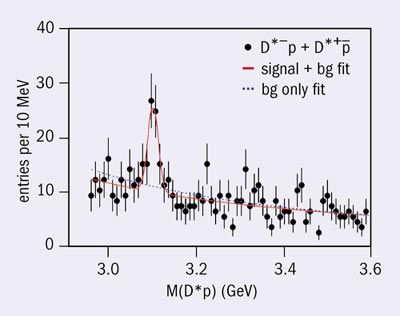
The H1 experiment studying electron-proton collisions at DESY’s HERA accelerator may have discovered a new five-quark particle. On 11 March the H1 collaboration reported clear evidence for a charmed pentaquark – a bound state of two up quarks, two down quarks and a charm antiquark (uuddcbar), with a mass close to 3100 MeV. However, in a preliminary investigation physicists from ZEUS, the other major experiment at HERA, found no evidence for such a particle in their data. The hunt is now on to discover whether the charmed pentaquark does indeed exist.
The search for the pentaquark became a hot topic in 2003, when several experiments reported evidence for a narrow five-quark state, the Θ+, containing a strange antiquark. This immediately raised the question of whether similar states exist, with the strange antiquark replaced by a charm antiquark corresponding to the charmed analogue Θ0c of the Θ+. Since DESY’s electron-proton collider HERA is a copious producer of charm quarks and antiquarks, H1 and ZEUS were quick to take up the search.
The evidence for the new pentaquark in the H1 data is a resonance in the invariant mass combinations of D*– mesons (dcbar) with protons (uud) and the antimatter equivalent, D*+ mesons with antiprotons. The resonance is remarkably strong and narrow, sitting on a moderate background at a mass of 3099 ± 6 MeV. It is unlikely that it is produced by statistical background fluctuations. The peak contains roughly equal contributions from D*–p and D*+pbar combinations. It survives all reasonable variations in the selection criteria and many other careful tests. A resonance with compatible mass and width is also observed in an independent photoproduction data sample from H1. This makes it more surprising that the ZEUS team could find no such resonance. Both HERA experiments are now carrying out further studies in an attempt to understand the results.
Other experiments now have to look in their data for such a state. Its decay to a D* and a proton implies that its minimal quark composition is uuddcbar. Not much more is yet known. The exact interpretation will depend on more detailed measurements and theoretical work. Is this the Θ0c, or an excited state with spin 3/2 instead of spin 1/2, or something completely different? If the state is confirmed, it is likely to be the first step towards a whole new spectroscopy of charmed pentaquarks, which could lead to an improved understanding of the forces that bind the quarks together.








